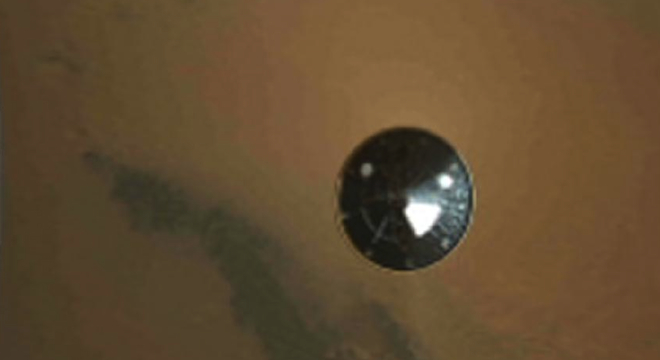NASA’s Mars Curiosity Rover had a picture-perfect landing on early Monday morning — quite literally, as a newly-released series of point-of-view images captured by the rover during its descent reveal.
The new full-color images — taken by an onboard, downward-looking camera, clearly show the rover rapidly approaching the surface of Mars during its final two and-a-half minutes before landing. The first image in the series of 297 images shows the rover landing craft’s heat shield being ejected from below.
Check out the following video composite of the images, released by NASA’s Jet Propulsion Laboratory late Monday, to get a sense of what the landing was like for the rover.
Other images released by NASA of the mission so far include a full-color view of the Martian horizon, new high-resolution shots of the rover’s surroundings snapped by the rover’s black-and-white hazard avoidance cameras and a spectacular overhead view of the rover opening its supersonic parachute during descent, though that one was taken by a satellite orbiting Mars, the Mars Reconnaissance Orbiter, not the rover itself.
But the shots of the landing sequence taken from the rover serve an important scientific purpose in their own right, according to NASA scientists.
“The image sequence received so far indicates Curiosity had, as expected, a very exciting ride to the surface,” said Mike Malin, imaging scientist for the Mars Science Lab mission from Malin Space Systems in San Diego, in a statement published on NASA’s website. He continued:
“But as dramatic as they are, there is real other-world importance to obtaining them. These images will help the mission scientists interpret the rover’s surroundings, the rover drivers in planning for future drives across the surface, as well as assist engineers in their design of forthcoming landing systems for Mars or other worlds.”
The photos were snapped by the rover’s Mars Descent Imager (MARDI) camera, a 1,600 by 1,200 pixel-per-frame camera slightly larger than a pocket knife, one of 10 different instruments on the nuclear-powered robotic vehicle. The MARDI camera, which took images at a rate of four-frames-per-second, was designed to provide an “astronaut’s view” of the Martian environment immediately surrounding the rover, according to NASA’s Jet Propulsion Laboratory.
The rover is now sitting in a shallow region of Mars in the northwest known as Gale Crater, just a few miles away from Mount Sharp, a 3.4-mile-high mountain that scientists plan to drive the six-wheeled rover toward in the coming days, to begin inspecting its lower layers for their geologic composition, looking for clues as to whether this area of Mars was ever covered with water and capable of supporting carbon-based life.






